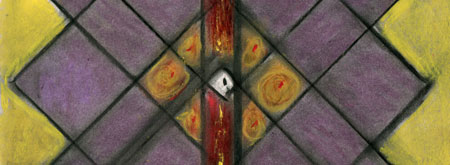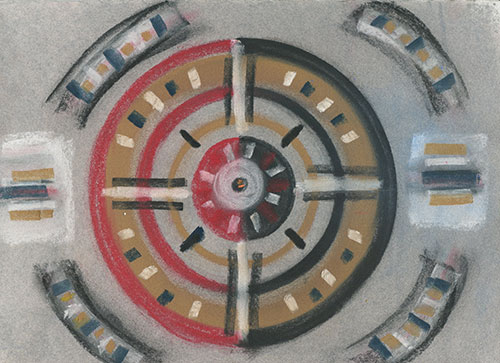Workshops
In a weekend workshop he offers clinic style led classes that investigate specific aspects of the practice in varying levels of detail according to the tastes of the workshop host. These investigative classes help students come to new perspectives on how to practice more intelligently, safely and joyfully.
David is skillful in providing explanations of elusive, often unspoken aspects of the practice. He also offers Mysore and Pranayama classes and also chanting and yoga philosophy discussions.
Mysore Intensives
A Mysore intensive provides the student with a concentrated and heightened learning experience that will help he/she develop practical and technical yoga skills and be immersed in the inspirational magic and poetic soul of the practice. The student will develop skill in applying the practice techniques in ways that are logical, challenging, intelligent and fun.
One focus will be on exploring learning how to follow the system at the same time as creating a practice that honors individuality, versatility and creativity. Each student will receive valuable one to one guidance from David on developing his/her personal practice. In addition to the Mysore sessions, there will be pranayama (one day per week), chanting and discussion of Yoga Sutra’s (one day per week) as well as other classes that focus on asana and pranayama theory, yoga philosophy, devotional poetry and teaching stories from sacred texts. Students also receive support from the amazing learning community that gathers at each Intensive. Of special note: the longest Mysore intensive that David teaches happens annually in Kovalam India.
Retreats
Retreats are from one to two weeks long and are set in beautiful, and remote settings. Beyond the Mysore, yoga sutras, and asana theory classes the focus of the retreat is in being quiet and having time for yourself to rest and contemplate your practice.
In Depth Studies
Are similar in purpose and content to the Mysore Intensive (see description). Additionally there are five central themes of the In-Depth Study:
- Mysore Class
- Asana study practical and theory
- Pranayama practical and theory
- Chanting and study of sacred texts (including Yoga sutra's, Hatha Yoga Pradipika, Shiva Samhita, Bhagavad Gita, stories from Hindu mythology and more.
- Independent Studies
1) Mysore Class
This was the teaching method of late Yoga master Sri K Pattabhi Jois in Mysore, South India, hence the source of the name “Mysore Style”. In a Mysore style class you memorize the Ashtanga sequences by learning one posture at a time in a manner similar to learning traditional chanting or music in India. As you repeat and master the postures within the given sequences, you gradually increase your knowledge and create an independent personal practice. One of the strong points of a Mysore class is the individual learning relationship that develops between you and the teacher. There is nothing of greater value than to receive input from a knowledgeable teacher that pertains to the highly specific, unique nature of your practice. The Mysore learning environment gives you the necessary access to the teacher, he/she sees your practice and is able to help you to create a custom practice that is tailored to your individual needs. Over time the Mysore class trains you to work independently and to make your practice truly yours. David is an unusually gifted teacher who has spent decades steeped in the tradition and engaged in serious practice.
2) Pranayama
This will be a concentrated study of breathing that will help you develop skill in breathing in your asana practice and also prepare you for learning the traditional ashtanga pranayama sequence as taught by Sri K Pattabhi Jois. Participants will gain knowledge of pranayama, the fourth yogic limb, and lay a foundation for establishing a personal breathing practice. The classes will include working on basic ujjayi (victorious breath), practicing such techniques as viloma (interrupting the breath), and khumbhaka (retaining the breath). The exploratory daily sessions will add entirely new dimensions to your overall practice.
3) Chanting and study of Yoga Sutras and other sacred texts
A) chanting
The Chanting portion combines the following aspects of yoga study: asana (posture), pranayama (breath control), dhyana (meditation), japa mantra (repetition of sacred sounds) jnana (intellectual study). Working with your breath, voice, and the internal vibratory sound qualities of chanting can teach you how to apply the foundational principles with more subtlety and accuracy.
B) lectures and discussions on the sacred texts.
The intellectual study of yoga is an essential means of ensuring progress and maturity in practice. Absorbing yoga philosophy is an important part of understanding the language of yoga and the images that go with it. Learning the yoga language provides you with the internal maps that lead you to heightened states of concentration and meditative awareness. You are able to reach higher stages of yoga by learning how to apply the philosophical/theoretical knowledge to your practice. You also begin to see how the theory and the practice are not separate objects of study, but rather are two aspects of the same applied, practical methodology. Meditating on the theoretical teachings helps bring you into more intelligent, accurate and subtle alignment in your postures.
4) Asana study and theory
The study of ashtanga yoga is at heart practical and experiential, it is based upon on an ongoing endeavor to use asana (posture) and breathing (pranayama) for meditation and self reflection in order to attain “spiritual realization”. Practice helps you awaken and develop an inner life, this means that you learn to direct your consciousness inward so that you can find Beauty, Knowledge, Art and other qualities that describe the Divine Source.
5) Independent Studies
It takes considerable time and practice to retain and to absorb the body of yoga knowledge that you are exposed to during the other 4 portions of the course. The independent sessions give you a formal opportunity to go back through the material in a way of your choosing. I call this portion “Samyama Studies” meaning perfect restraint or intense focus. You spend the time singling out various parts of the material, you take time to review, repeat, and reflect. You contemplate what you like and what might be of most value to you. You work to identify where the gaps in your learning are, where there is understanding or confusion, where you are drawn to study further.
Daily Sample Schedule
Mysore Class
7:45 - 9:45 am
Pranayama
9:45-10:30 am
Yoga sutras chanting and study
10:30-11:30 am
Asana Clinic
12:30-2:00 pm
Sanyama Independent Studies
2:00-3:00 pm
Teacher’s Intensives
This course will help serious students and teachers gain skill in sharing the technology of hatha yoga with others. The teaching methodology comes from the perspective of various sets of internal maps that are drawn from the sacred texts.
AREAS OF FOCUS
- Adjustment techniques that emerge from asana research including therapeutics
- Effective use of hatha techniques that support asana (pranayama, bandha’s dristi etc)
- Inquiry into the meditation aspect of hatha yoga techniques
- The role of pranayama in practice
- Being part of a lineage
- Use of tantric imagery to understand the practice in energetic terms
- Seeing and working with the body based on bio mechanics of posture and movement
- Philosophical studies that are accessed through: 1) Japa Mantra (chanting of sacred texts) 2) Contemplation and discussion on the meaning of the texts
- Inquiry into the possible practical applications of the texts.
This intensive is not part of a “certification” course, since such certification in the Ashtanga Vinyasa style is granted only in Mysore India by K. Pattabhi Jois’ grandson, Sharath Rangaswamy. And yet this course will be provide valuable and rewarding knowledge for those who want to become more articulate, skilled and confident teachers. The material will be accessible to many levels of participants each will be free to work within his/her own current practice capacities.
Notes on the Course
This course will help serious students and teachers gain skill in sharing the technology of hatha yoga with others. The teaching methodology comes from the perspective of various sets of internal maps that are drawn from the sacred texts including the 8 eight limbs, 5 vayu’s, 5 kosha’s, tantric imagery, and the 5 asana allies (foundation, breathing, central axis, locks, and gazing). The course content will include:
1) Applying asana and pranayama theory to the art of teaching
This section will focus on developing skill in the practical, physical ‘hands on’ aspects of teaching. The study will include how to give effective physical and verbal adjustments. The research will also include using the 5 allies to ‘see’ and to read the body. Using the 5 allies provides a primary means of helping the student create an intelligent and soulful individual practice.
2) Approaching teaching through studies of the sacred texts
Behind the physical teaching techniques there is a greater context for practice (and for teaching) that is rooted in the invisible mysteries of spirit and soul. The aim of yoga is to hit the internal target of Self, the yogi does this by hunting for the sacred consciousness within his/her own body. The philosophical yoga texts go to great lengths to describe the nature of Spirit and Soul and the nature of inner consciousness. The texts contain clues that help each seeker to know the nature of the glorious mystery. Studying the sacred texts provides a primary source of knowledge for the serious student and the teacher. The texts articulate practical, theoretical and philosophical knowledge that gives the student a beneficial context for applying the physical techniques. Studying the greater philosophical context for the practice offers protection, it reduces risk of harm and injury, and helps the student to fulfill the full promise and purpose of daily practice.
Studying the sacred texts helps the student to enter into the subject of teaching in a spirit of creativity and intellectual curiosity. The texts are the guides that reveal and inform the hatha yoga techniques. These teachings help the student to cultivate open learning environment that welcomes the two qualities of paradox and contradiction. The presence of these qualities is essential for a fruitful inquiry into the secrets of yoga. Answers to the profound questions postulated by the subject of yoga are found beyond simplified, black and white thinking. The texts welcome the complexity that comes from embracing the multitude of variables that make up a serious study of yoga.
Semi-Private Mysore Classes
Semi Private Mysore classes include an hour and 45 minute Mysore class plus an additional half-hour on specific hatha yoga subjects that David chooses. Subjects include pranayama, bandhas or asana theory. These special classes are an excellent opportunity for students to receive one on one instruction from David about their practice in a small group setting.


